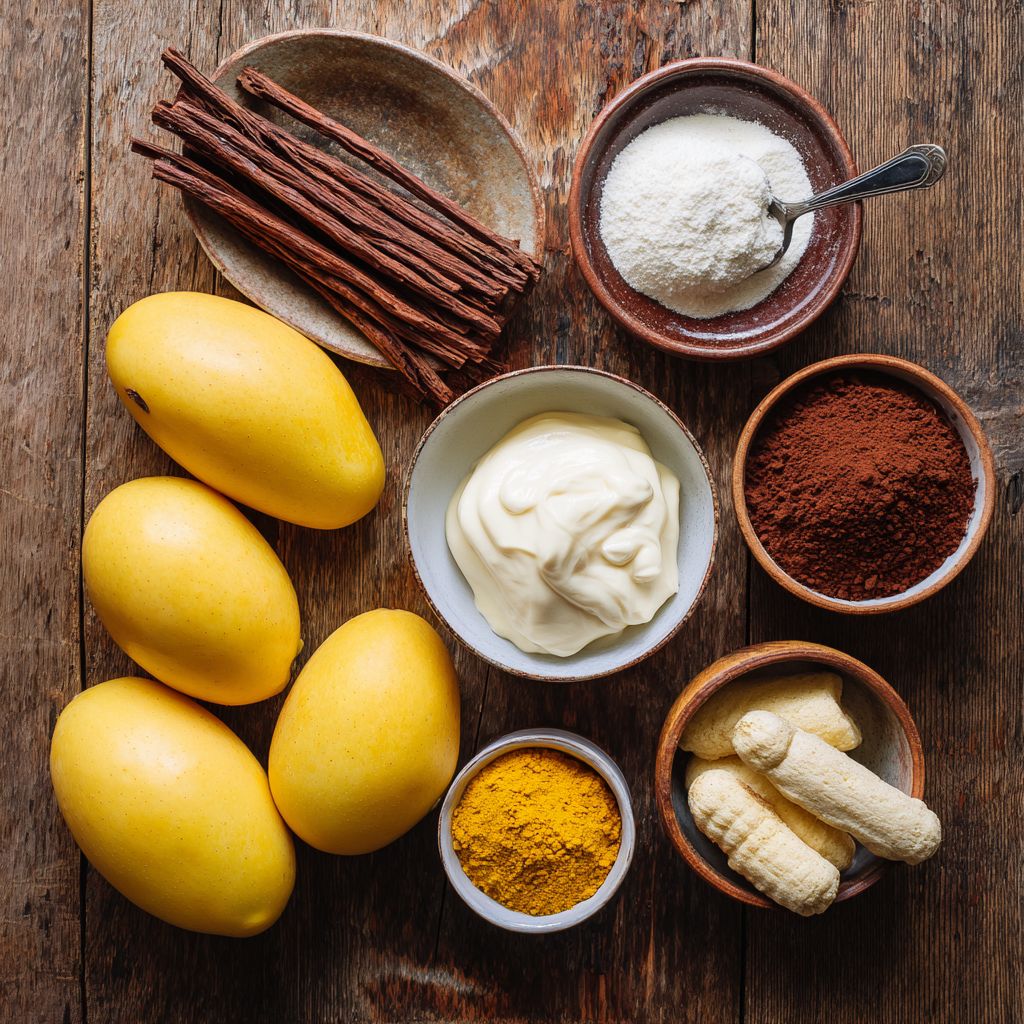
If you love the creamy richness of classic tiramisu but want something lighter, fruitier, and perfect for summer, then Mango Tiramisu is the dessert you’ve been waiting for. This refreshing version keeps the beloved layers of ladyfingers and mascarpone but replaces the traditional coffee with sweet, juicy mango. The result? A no-bake mango tiramisu recipe that’s vibrant, indulgent, and surprisingly easy to prepare.
This tropical twist is more than just dessert—it’s an experience. Whether you’re planning a family gathering, a summer party, or simply want a quick indulgence, eggless mango tiramisu delivers elegance without fuss. And the best part? You’ll find endless variations to try, from individual mango tiramisu cups to creative spins like mango lassi tiramisu.
Want to explore even more creative desserts? Don’t miss our full guide: Tiramisu Variations – 25 Modern Recipes You Need to Try.
Table of Contents
ToggleWhy You’ll Love This Mango Tiramisu
What makes this recipe so irresistible is its perfect balance between simplicity and flavor. Unlike the traditional version, mango tiramisu skips raw eggs, making it safer and more approachable for home bakers. Instead, it combines mascarpone and whipped cream for a smooth, light texture.
Here’s why you’ll fall in love with this tropical delight:
- Eggless and alcohol-free – perfect for kids and guests with dietary restrictions.
- No-bake mango tiramisu – no oven required, just layer and chill.
- Quick assembly – only 10 minutes of hands-on time.
- Versatile – serve it as a full cake or in elegant mango tiramisu cups.
- Refreshing twist – ripe mangoes bring natural sweetness and a summer vibe.
This dessert feels like sunshine in every bite. And just like Blueberry Tiramisu or Raspberry Tiramisu, it shows how tiramisu can evolve into exciting new creations.
Key Ingredients for Mango Tiramisu

The magic of mango tiramisu lies in how simple yet flavorful its ingredients are. You don’t need anything complicated—just a few staples that transform into a show-stopping dessert.
Mango pulp and fresh mangoes
Mango is the star of this dessert. Use sweet, ripe varieties like Alphonso, Ataulfo, or Kesar mangoes for the best flavor. Fresh mango slices bring texture, while mango pulp creates a silky, fruity base. If fresh mangoes aren’t available, canned mango pulp is a fantastic alternative.
Mascarpone cream layer
This layer brings the signature tiramisu creaminess. A mix of mascarpone cheese, heavy cream, and a touch of sugar creates a smooth, airy filling. Some variations even fold in mango purée for a brighter color and fruitier taste, making it a true mango mascarpone cream.
Ladyfingers and mango nectar
Instead of dipping ladyfingers in coffee, this recipe calls for mango nectar or a simple mix of mango pulp and water. It keeps the biscuits moist without overpowering them, allowing the mango flavor to shine. For an extra twist, you can try combining mango with passionfruit for a tangy variation.
Step-by-Step Mango Tiramisu Recipe

Making mango tiramisu is surprisingly easy—it’s all about layering and letting the flavors blend while chilling.
Prepare the mango sauce or pulp
Blend fresh mango chunks or use ready-made mango pulp. For a tangy boost, add a squeeze of lemon juice. Chill the pulp before assembling for a fresher taste.
Make the mascarpone cream
Beat mascarpone cheese with sugar until smooth. Gently fold in whipped cream to keep it airy. Optional: mix in a spoonful of mango pulp for a richer color.
Dip and layer the ladyfingers
Quickly dip each ladyfinger into mango nectar or diluted pulp—just enough to soften without making them soggy. Arrange a base layer in your dish or serving cups.
Assemble the layers
Spread a layer of mascarpone cream. Add a spoonful of mango pulp and a few fresh mango cubes. Repeat the process until your dish is full.
Chill and serve
Refrigerate for at least 4 hours (overnight is ideal). Before serving, garnish with mango slices, cocoa dust, or even coconut flakes.
This method works perfectly for large trays as well as individual mangos tiramisu cups, making it versatile for any occasion.
Creative Variations of Mango Tiramisu

One of the best things about Mango Tiramisu is how versatile it can be. Depending on your mood or the occasion, you can easily customize it with a few creative twists.
- Eggless Mangos Tiramisu – Skip eggs entirely and rely on mascarpone and cream for a smooth, indulgent texture. This version is family-friendly and hassle-free.
- Mangos Tiramisu Cups – Serve your dessert in glass cups or jars for portion-controlled elegance. Perfect for dinner parties or picnics.
- Mango and Passionfruit Tiramisu – Add passionfruit pulp to the mango layer for a sweet-tangy contrast that elevates the tropical vibe.
- Mango Lassi Tiramisu – Inspired by the classic Indian drink, this version combines yogurt and mango pulp with mascarpone for a refreshing twist.
- Mango Graham Tiramisu – Swap ladyfingers for graham crackers, a Filipino favorite that’s just as delicious and easy to find.
Just like Ube Tiramisu, these variations show how the classic Italian dessert can adapt beautifully to local flavors and preferences.
Expert Tips to Perfect Your Mango Tiramisu
Mango Tiramisu may be simple, but a few smart tips will help you master it every time.
- Use ripe, sweet mangoes – The natural sweetness makes a huge difference. If mangoes are slightly tart, balance with a touch of sugar in the pulp.
- Don’t oversoak ladyfingers – A quick dip in mango nectar is enough. Too much liquid will make them soggy and ruin the structure.
- Whip the cream cold – For a stable mascarpone mixture, ensure your heavy cream is well chilled before whipping.
- Chill overnight – While four hours is fine, leaving your Mangos Tiramisu overnight deepens the flavor and improves texture.
- Play with toppings – Fresh mango cubes, cocoa dust, or even a drizzle of mango purée can take the presentation to another level.
These small details transform a good mango tiramisu recipe into a showstopper dessert. And much like Tiramisu Cupcakes, they prove that presentation matters just as much as flavor.
How to Store Mango Tiramisu Properly

Since Mango Tiramisu is a no-bake dessert with fresh fruit and cream, proper storage is key to maintaining flavor and freshness.
- Refrigeration – Always store Mango Tiramisu in the fridge, covered with plastic wrap or in an airtight container. It stays fresh for up to 3 days.
- Avoid freezing – Freezing changes the texture of mascarpone and mango pulp, making it watery once thawed.
- Assemble in advance – You can prepare the mascarpone cream and mango pulp a day ahead, then assemble just before serving.
- Refreshing leftovers – If the cream looks a little flat after a day, garnish with fresh mango slices or a dusting of cocoa to revive its look.
This dessert is at its best when enjoyed fresh, but even after a couple of days, it still delivers that fruity, creamy indulgence. For another make-ahead delight, try our No-Bake Tiramisu Cake.
Frequently Asked Questions about Mango Tiramisu
1. What is Mango Tiramisu?
Mango Tiramisu is a tropical twist on the classic Italian dessert. Instead of coffee-soaked ladyfingers, this version uses mango pulp, nectar, or juice to layer with mascarpone cream and fresh mango slices.
2. Can I make Mangos Tiramisu without eggs?
Yes! Eggless Mango Tiramisu is very popular. You can achieve a smooth and creamy texture using just mascarpone, whipped cream, and mango purée, without compromising flavor.
3. Can I replace ladyfingers in Mango Tiramisu?
Absolutely. If ladyfingers are hard to find, you can use graham crackers, sponge cake, or even local alternatives like Filipino broas. Each option gives a slightly different texture but keeps the recipe delicious.
4. How long does Mango Tiramisu last in the fridge?
When stored properly in an airtight container, Mango Tiramisu lasts up to 3 days in the refrigerator. For the best taste and texture, enjoy it within the first 24–48 hours.
5. Is Mango Tiramisu suitable for kids?
Yes! Since this dessert contains no alcohol or coffee, it’s a family-friendly option. Kids love its fruity sweetness and soft, creamy texture.
6. Can I freeze Mango Tiramisu?
It’s not recommended to freeze Mango Tiramisu, as the cream and mango layers lose their smooth texture when thawed. Instead, prepare it fresh and refrigerate until serving.
Conclusion
Mango Tiramisu is more than just a fruity dessert—it’s a fresh, tropical celebration of flavors. By blending ripe mangoes, creamy mascarpone, and soft ladyfingers, this recipe delivers a no-bake indulgence that’s both easy and elegant.
Whether you prepare an eggless mango tiramisu, a layered version with passionfruit, or a playful mango graham tiramisu, each bite captures the perfect balance of richness and refreshment.
It’s a dessert made for sharing, but also one you’ll want to keep for yourself. From casual family dinners to festive gatherings, Mango Tiramisu always stands out as a crowd-pleaser.
If you enjoyed this recipe, don’t miss our other delicious twists in the Tiramisu Variations – 25 Modern Recipes You Need to Try collection, including Ube Tiramisu, Biscoff Tiramisu, and Blueberry Tiramisu. Each one brings a unique spin on the beloved Italian classic.
So go ahead—grab those ripe mangoes and make this tropical dream come true. One spoonful, and you’ll see why Mango Tiramisu deserves a permanent spot on your dessert table.
About This Recipe
This Mango Tiramisu recipe has been created with a focus on simplicity and authenticity, combining Italian dessert tradition with fresh tropical ingredients. It has been tested in a home kitchen setting and refined based on reader feedback to ensure consistent, delicious results.
For nutritional references, mangoes are a rich source of vitamin C and antioxidants, while mascarpone provides calcium and protein. You can find detailed nutritional values for mangoes and dairy products on the official USDA FoodData Central.
At Tiramisucake.com, we follow E-E-A-T principles:
- Experience – Recipes are tested in real kitchens with practical tips from home cooks.
- Expertise – Content is crafted with culinary research and guided by traditional Italian methods.
- Authoritativeness – We reference reputable sources like USDA for accurate nutritional data.
- Trustworthiness – Every recipe is clearly explained, with variations and substitutions provided for accessibility.




